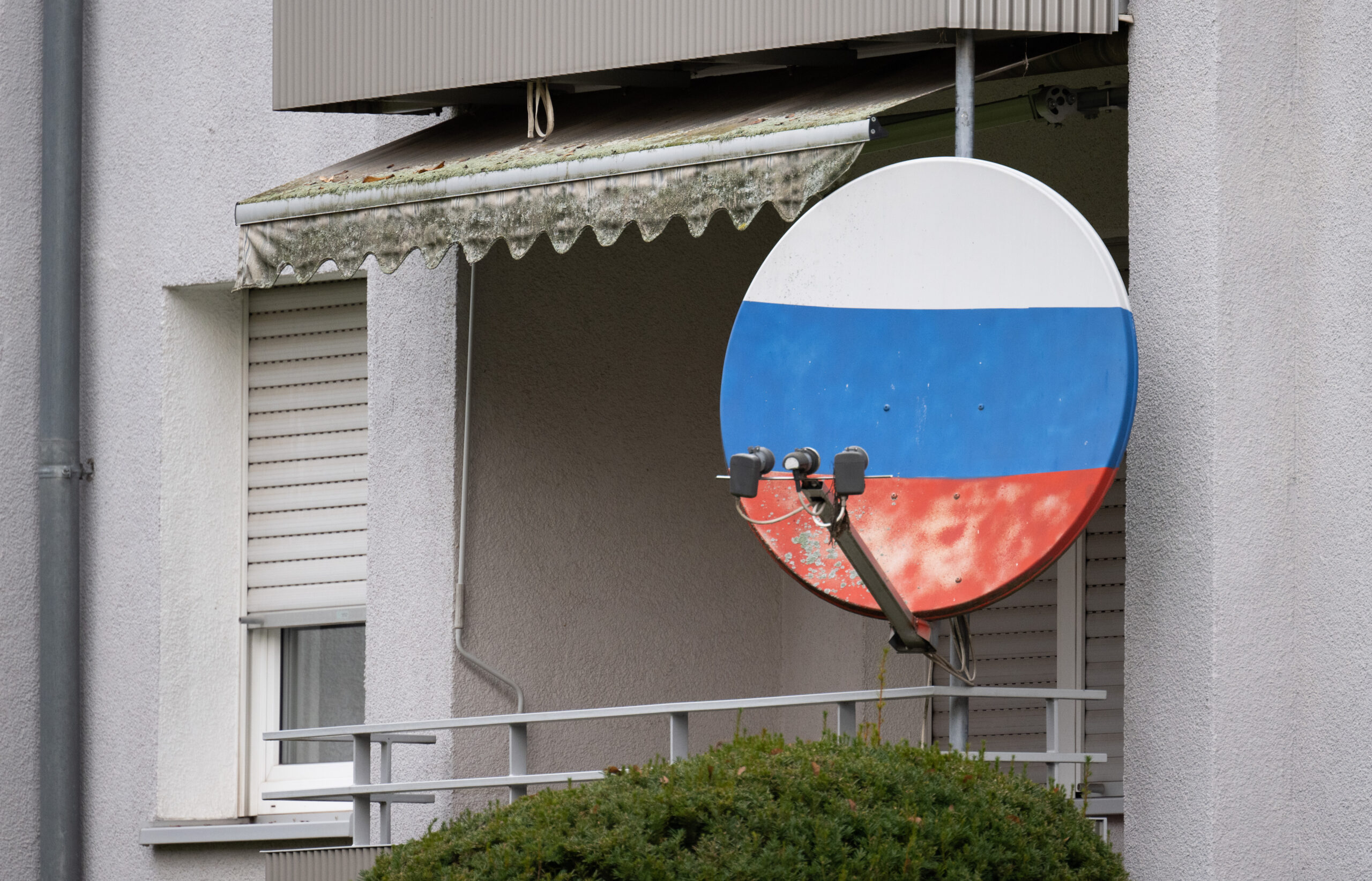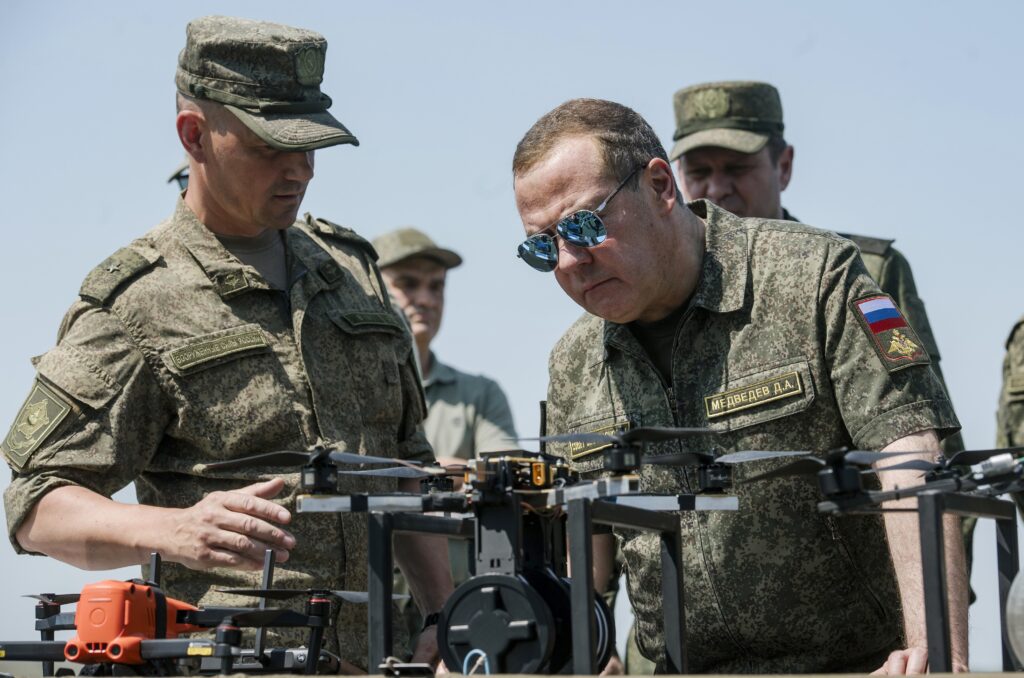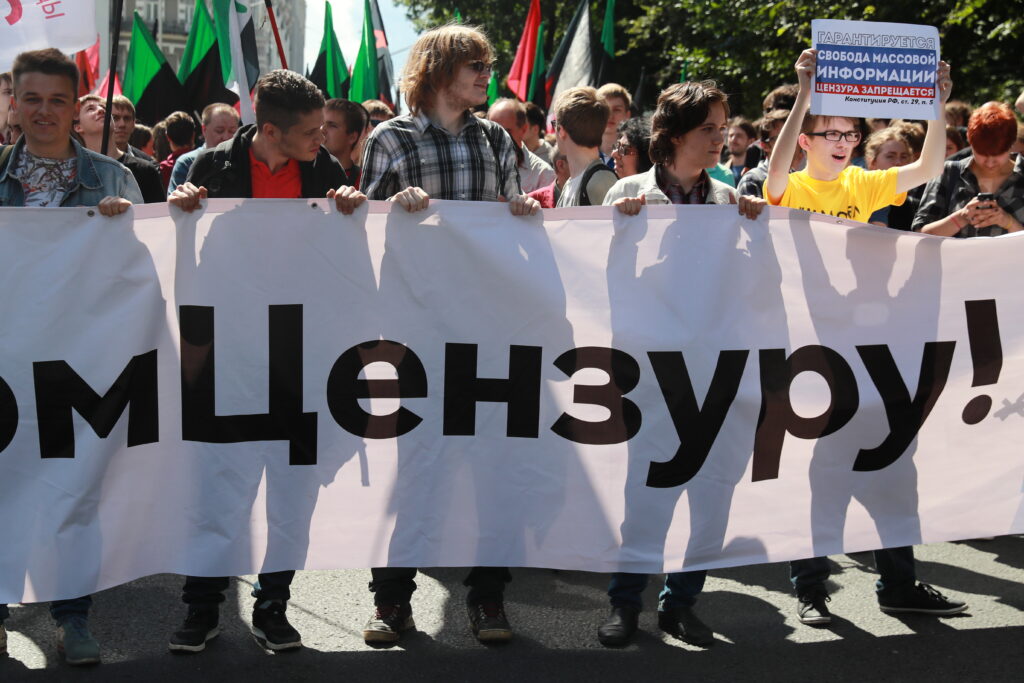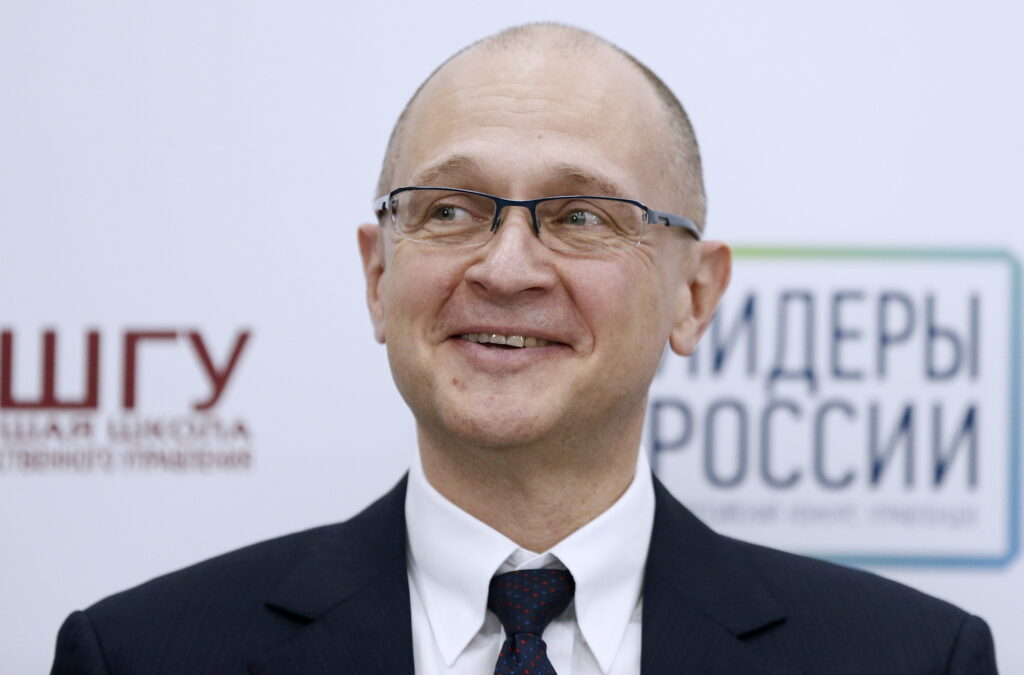The ‘zombie’ debate of how many Russians support the war has often eclipsed more analytically useful investigations into broader Russian perceptions of the full-scale invasion of Ukraine. Western-based discussions of the Russian information space and public attitudes tend towards unhelpful binaries of «support» or «don’t support». However, far from everyone in Russia perceives the war or the Kremlin in black or white. State-aligned propaganda — or media that is supportive of and constrained by the Kremlin but not necessarily state-controlled — is sensitive to this. Rather than a totalising attempt to turn audiences into ‘true believers’, state-aligned propaganda tries to nudge them along a spectrum of acceptable information outcomes for the authoritarian state.
How does propaganda work in authoritarian states?
Any successful effort at mass persuasion requires two things: a platform, so audiences encounter your narrative; and resonance, so it appeals to and fits with viewers’ understandings and experiences of the world. Vladimir Putin set out to establish control over the media from the earliest days of his first presidential term in 2000. Over the years, the situation for freedom of media and speech degraded further, as exemplified by the wide-ranging censorship laws imposed in March 2022.
But in the 21st century authoritarian state, it is close to impossible to establish a monopoly on information; hence, propaganda needs resonance as well as a platform, although this resonance can be acquired in different ways. A news item or narrative might mobilise support in those who are already inclined to such views; but in others it will simply spark what the anthropologist Jeremy Morris calls a ‘defensive consolidation’ — we’re here now so what can we do, let’s stick together. In others still, the same item can demobilise opposition, either directly through fear or indirectly by encouraging people to disassociate from the war. Research on Chinese news media found that heavy-handed, over-the-top propaganda backfired in the sense that viewers were less likely to trust and support the narratives; however, it also made them less likely to protest, because they interpreted it as a demonstration of the sheer power of the state.
In Russia’s case, the pro-Kremlin media emphasises the manipulative nature of politics, reducing belief in the power of individual or collective political action. Capitalising on distrust, they seek to persuade people that it is not possible to discern the truth — about a specific topic or in general. But when human beings believe nothing can be trusted, they will still look for, and need, some support and criteria through which to parse the world and evaluate events. Often they will create such a framework out of events, memories, emotions they instinctually understand. People may well feel such knowledge is ‘safe’ from manipulation but this is actually where the Kremlin’s propaganda excels itself, given that the government and its allies have worked hard to develop and propagate through popular culture a militaristic vision of a resurgent messianic Russian identity at odds with the malicious West.
Model behaviour
As such, the Russian propaganda machine is paradoxically less total and more all-encompassing than it may appear. But to understand how — and why — the narratives resonate, we must focus on audiences too. In a country where saying you are against the war carries the potential of a long jail sentence, there should be considerable caution towards using polling as a reliable indicator of mass Russian support for the war. But that doesn’t mean we should stereotype attitudes or dismiss agency. A number of excellent new polling organisations, like Chronicles and Russian Field, are filling in certain gaps. We can also look at media consumption and engagement, which when viewed more generally, can point to interest, if not resonance.
Florian Toepfl’s notion of the three types of authoritarian publics — uncritical, policy-critical, or leadership-critical — is useful here. These publics in turn consist of a variety of partial publics to be discerned through expertise in the regional and socio-cultural context of the given country/ies. In interviews with Russians discussing Ukraine, war (since 2014 and since 2022), and national identity, I have encountered a wide range of arguments, few of which are as binary as ‘for’ or ‘against’ the Kremlin.
The opinions expressed can be broken down into manifold sub-views or groups, but some of the most prominent include: nationalist, russkii mir-sympathetic, ultra-patriots, Orthodox or traditional values supporters, cynical careerists, ‘common-sense’ patriots, defensive patriots, the apolitical, apathetic, or opposition of various hues. To understand more about the types of narratives being consumed by different partial publics — or audiences — I downloaded via Popsters the Telegram data (almost 75,000 posts) for 16 highly popular but variegated channels between 24 February and 20 May 2022. With an assistant, I coded their content by virality (as determined by the amount of viewer engagement) and theme.
I selected Telegram due to the (relative) lack of censorship, its popularity, and because it covers a different and mostly younger demographic to television, which is mainly oriented towards an older generation. That said, I am not making any claims that the selected Telegram channels are representative of all Russian views on the war. It is but a sample of the variety of narrative and approach available. With these caveats out of the way, albeit fair from exhausted, let us turn to the findings from 1575 posts — the most popular 100 posts in terms of viewer engagement for each channel.
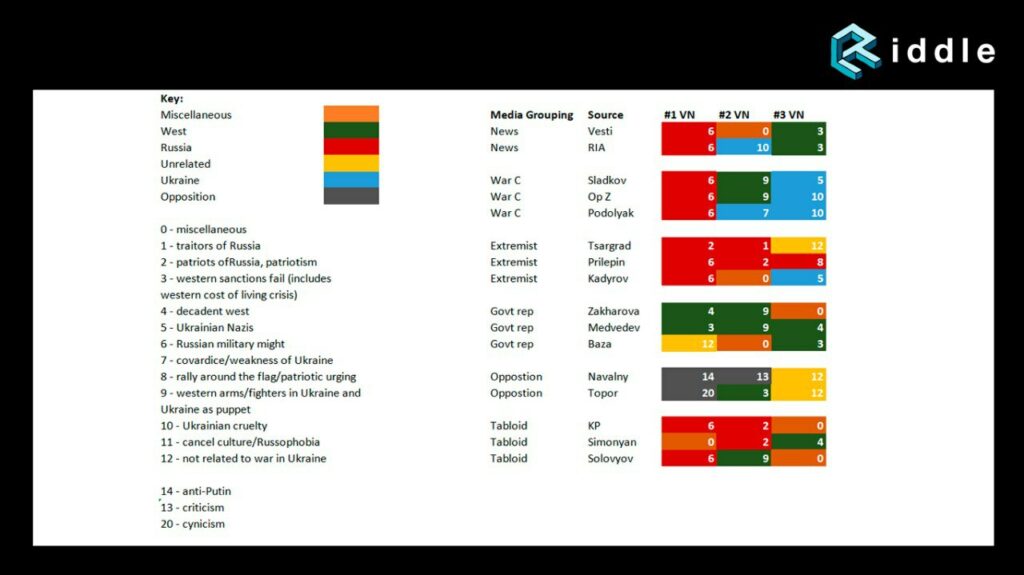
The table above shows the three most viral narratives by channel (VN — viral narrative). One of the most evident findings concerns the diversity of focus depending on types of channel and the lack of engagement with Ukraine as a topic, except among the war correspondents. Ironically, given that Russian propaganda so rarely focusses on domestic news, the narratives grouped together under ‘Russia’ content are easily the most prominent. This is primarily driven by narrative #6: military might. This narrative was most viral among war correspondent and news channels. Indeed, First Channel’s war correspondent, Sladkov, wrote about little else and 90.3 per cent of his most viral posts comprised flashy war shots, largely unrepresentative of facts on the ground.
Yet, the military might theme hardly featured at all in Baza’s coverage or on MFA spokeswoman Maria Zakharova’s channel or Dmitrii Medvedev’s. This partly reflects the comparative lack of videos on these channels but, for the latter two politicians, it also speaks to a greater concern with discrediting the West. Another prominent narrative within the ‘Russia’ content group, notable among the tabloid and ‘extremist’ (used to designate that views in such channels are not mainstream for state media) channels, is the use of narrative #2: Russian heroes. The tabloid channels focussed heavily on celebrities as patriots, showing them helping Donbas children or holding concerts in newly ‘liberated’ territories. The extremist channels used a similar tactic of ‘modelling heroic behaviour’ but they largely used ordinary people and soldiers, not celebrities.
In short, among the most viral narratives, we do not find just one narrative, but rather a range of different content framed differently for different audiences. Nor do the narratives remain static. The audiences are also dynamic, their views evolve, and the media needs to respond to this and to events on the ground. This is reflected in the table below which examines the narrative group prominence by month:
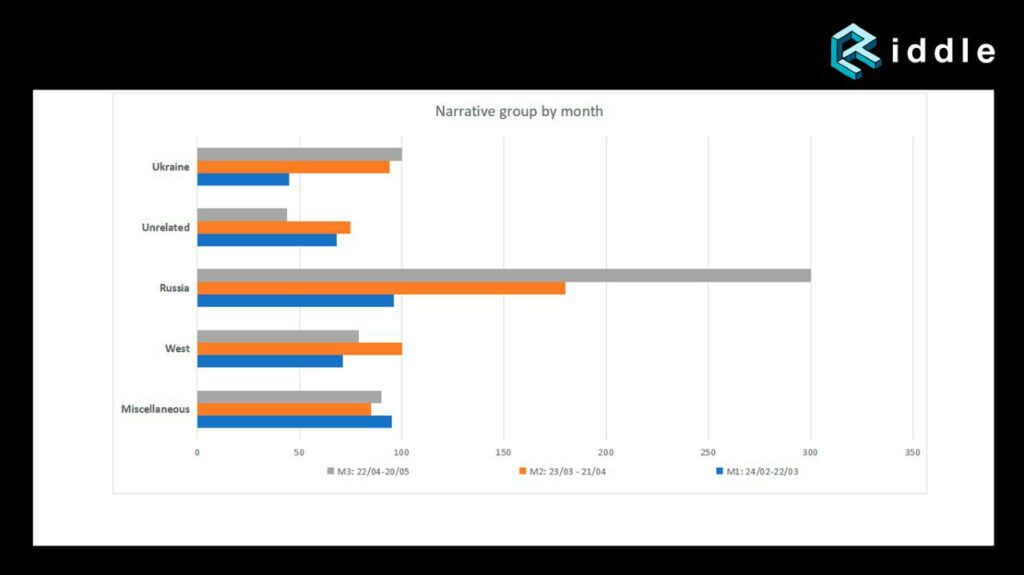
The table above focusses only on state-aligned media, not opposition sources. In measuring and comparing the former, the ‘unrelated to war’ group functions as a useful comparative. For example, in month one, this group featured in viral posts more than references to Ukraine, but by the end of March the situation has reversed. This was undoubtedly influenced by channels featuring Ukraine more prominently within explanatory content on why the ‘Special Military Operation’ was not a three-day victory. The virality therefore reflects not only an interest in this topic but also the increased frequency of such content. While Russian television often offers an unhealthily prominent focus on the West, it is noteworthy that there was no increase in this theme among viral content in most of the selected Telegram channels. There is, however, remarkable growth in the use of ‘Russia’ content, much of which pertained to presenting Russia as (still) a strong and mighty military power and to produce, if not a sense of patriotic pride, then at least a ‘defensive consolidation’ during wartime.
Looking at these narratives, their shifts, and the range of channels, there is a clear sense of dynamic differentiation that is best visualised using a spectrum. Breaking down the type of narratives according to the type of publication and its target audience, including whether they are more inclined towards criticism of policy (i.e. how the war is being waged) or leadership (Vladimir Putin), I suggest that a spectrum of allies model is a useful model for understanding how state-aligned media interact with audiences and how this intersects with Kremlin information policy ambitions.
The original spectrum of allies model comprises active support, passive support, neutral, passive opposition and active opposition and works on the assumption that movements seldom win by overpowering the opposition; they win by shifting support out from under it. Nudging them further along the spectrum of allies: from passive opponent to neutral, from neutral to passive support, from passive support to active support.
The broader state-aligned media space can be interpreted using a model based on similar principles but with some important adaptations. It comprises active support, ritual support, loyal neutrals, apathy and active opposition. Notably, the Russian government does not just ignore but sets out to either destroy active opposition (physically or by outlawing their views) and/or to render them apathetic
Some state-aligned media narratives appear designed to nudge the apathetic into loyal neutrality (‘my country, right or wrong’), while others shift loyal neutrals into ritual supporters. Ritual supporters here designates those who support the government’s approach but in a more plebiscitary way, seeing themselves as aligned with the government’s position, rather than those intensely involved with the ‘Ukraine question’. For a 21st century authoritarian government, ritual supporters are the ideal category, insofar as such regimes distrust political agency even if in support of the regime. An obvious example of this would be the arrest of pro-war demonstrators detained under anti-protest laws by Russian police. As such, the government uses aligned sources to shuffle active supporters into the ritual support category, creating clear boundaries for acceptable ways to show allegiance.
The authoritarian spectrum of allies approach is a useful — if slightly heuristic — way of grouping Russian publics according to their interaction with and consumption of narratives, including pro-regime narrative resonance and persuasiveness. The spectral nature of the model also encourages a less binary and more nuanced understanding of the Russian information space on Telegram — and perhaps beyond. It also contextualises certain findings relating to the Russian media and state, such as the Presidential Administration’s longstanding obsession with polling and the way certain (critical or extreme) narratives are tested on some audiences but not others.
It would be a mistake to see the spectrum of allies as the Kremlin’s deliberate approach, rather than a model for understanding how a situation partly created by the Kremlin works in practice. The media is also an important actor here and editors are expected to know their own audience and trade. Five days a week a state-controlled consultancy issues a detailed list of six-to-ten topics ‘designed to supplement the Ministry of Defence’s war updates that constitute mandatory coverage’. However, there is considerable interpretative freedom to make the most of these materials, combined with a competition raging for audiences and state approval. The approach is one of neoliberal capitalism, where we might understand editors and newsmakers as salesmen: they have a product to sell and a script to guide them but they can, and must, add their own flourishes to the sales process. Their positions depend on sales figures. Ultimately, it is up to them to convince their customers and make enough sales.
All of which returns us to the core argument underpinning the models and the data. Russian state-aligned media imposes constraints on political freedom but also recognises — and fears — audience agency, which it seeks to co-opt in a variety of ways, including rendering people apathetic, bamboozling them, encouraging defensive consolidation, drawing on traumas, appealing to a sense of belonging or unmet political or social need, and so on. The Kremlin has not limited its concerns to the ‘pro’ and ‘anti’ extremes of the spectrum, and nor should analysts. Propaganda works in ways that are much more complex than a for-or-against binary. Narratives are not facts, they are ways of ordering information into a story, ways of crafting meaning. For them to make sense to audiences they need to resonate with people’s pasts and the contours of their lives and how they see themselves in relation to the world around them. To understand this, we require understanding of the discursive context, the media, the sociopolitical environment, and basic human psychology; but we also need empathy, the ability and willingness to understand how other people reached a different point of view, one we might find hideous, without dismissing it as evidence of brainwashing, evil, or a ‘slave mentality’.
